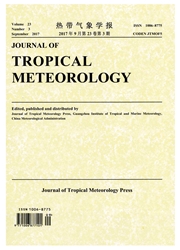

 中文摘要:
中文摘要:
The relationships of variations of sea surface temperature anomalies (SSTA) in the South Pacificwith ENSO and Southern Hemisphere Annular Mode (SAM) are examined in the present article byemploying the NCEP-NCAR reanalysis from 1951 to 2006. Two principal modes of South Pacific SSTA areobtained using the EOF (Empirical Orthogonal Function) analysis for austral winter (June, July and August).Our results suggest that EOF1 is closely related with ENSO and EOF2 links to SAM. The EOF1 varieslargely on an interannual and EOF2 on a decadal scale. The time series of coefficients of EOF1 is highlycorrelated simultaneously with Nino3 index. However, the time series of coefficients of EOF2 issignificantly correlated with the March-April-May mean SAM index. Both the EOF1 and EOF2 are found insignificant correlation to summer precipitation over China. With higher-than-normal SSTs in the easternSouth Pacific and simultaneously lower SSTs in the western South Pacific in June-July-August, thesummertime rainfall is found to be less than normal in northern China. As displayed in EOF2 of SSTA, inyears with lower-than-normal SSTs in mid-latitude southern and equatorial eastern Pacific andhigher-than-normal SSTs in the equatorial middle Pacific in March-April-May, the summer precipitation inAugust tends to be more than normal in regions south of Yangtze River.
 英文摘要:
英文摘要:
The relationships of variations of sea surface temperature anomalies (SSTA) in the South Pacificwith ENSO and Southern Hemisphere Annular Mode (SAM) are examined in the present article byemploying the NCEP-NCAR reanalysis from 1951 to 2006. Two principal modes of South Pacific SSTA areobtained using the EOF (Empirical Orthogonal Function) analysis for austral winter (June, July and August).Our results suggest that EOF1 is closely related with ENSO and EOF2 links to SAM. The EOF1 varieslargely on an interannual and EOF2 on a decadal scale. The time series of coefficients of EOF1 is highlycorrelated simultaneously with Nino3 index. However, the time series of coefficients of EOF2 issignificantly correlated with the March-April-May mean SAM index. Both the EOF1 and EOF2 are found insignificant correlation to summer precipitation over China. With higher-than-normal SSTs in the easternSouth Pacific and simultaneously lower SSTs in the western South Pacific in June-July-August, thesummertime rainfall is found to be less than normal in northern China. As displayed in EOF2 of SSTA, inyears with lower-than-normal SSTs in mid-latitude southern and equatorial eastern Pacific andhigher-than-normal SSTs in the equatorial middle Pacific in March-April-May, the summer precipitation inAugust tends to be more than normal in regions south of Yangtze River.
 同期刊论文项目
同期刊论文项目
 同项目期刊论文
同项目期刊论文
 ENSO-Independent Contemporaneous Variations of Anomalous Circulations inthe Northern and Southern He
ENSO-Independent Contemporaneous Variations of Anomalous Circulations inthe Northern and Southern He The Extreme Drought Event during Winter–Sprin g of 2011 in East China: Combined Influences of Teleco
The Extreme Drought Event during Winter–Sprin g of 2011 in East China: Combined Influences of Teleco Climatological characteristics of frontogenesis and related circulations over East China in June and
Climatological characteristics of frontogenesis and related circulations over East China in June and Interdecadal Linkages Between the Pacific Decadal Oscillation and Interhemispheric Air Mass Oscillat
Interdecadal Linkages Between the Pacific Decadal Oscillation and Interhemispheric Air Mass Oscillat The seasonal cycle of redistribution of atmospheric mass between continent and ocean in the Northern
The seasonal cycle of redistribution of atmospheric mass between continent and ocean in the Northern 期刊信息
期刊信息
